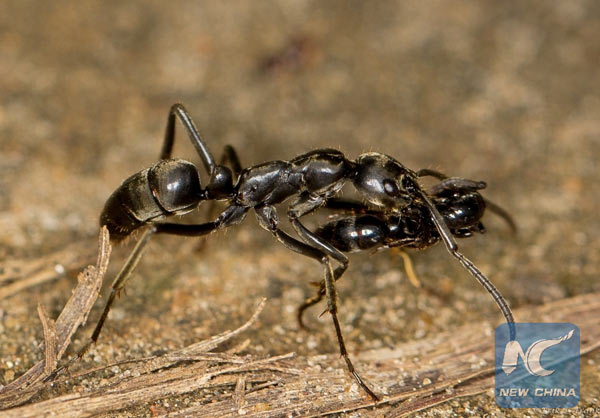WASHINGTON, April 12 (Xinhua) -- For the first time, scientists have found a species of ants that will rescue its injured soldiers and bring them back home to recover.

A Matabele ant is seen carrying an injured mate back to the nest after a raid in this handout photo provided April 12, 2017. (Xinhua/Courtesy of Erik Frank)
In a study published Wednesday by the U.S. journal Science Advances, researchers found that when an African Matabele ant is injured in a fight with termites, it will "call" its nest mates for help by excreting chemical substances.
The injured ant is then carried back to the nest where it can recover after receiving treatment that usually involves removing the termites still clinging to the insect.
"We have observed helping behaviour vis-a-vis injured animals for the first time in invertebrates," study author Erik Frank, a Ph.D. student at the University of Wurzburg in Germany, said in a statement.
"This was an unexpected finding, especially for social insects, where individuals are usually of little value."
African Matabele ants are widespread south of the Sahara and are a specialized termite predator. They set out to hunt prey two to four times a day.
Proceeding in long files, the ants raid termites at their foraging sites, killing many workers and hauling the prey back to their nest.
These attacks, however, are met with resistance and the ants get involved in fights with termites of the soldier caste, according to the researchers.
Injury and mortality can occur during such combats, as the soldiers are very adept at using their powerful jaws to fend off the attackers, they said.
Luckily for these injured ants, nestmates often picked them up and brought them home.
Nearly all rescued ants were found to participate in subsequent invasions -- sometimes less than an hour after injury.
In experiments that forced the injured ants to return home alone, 32 percent of them died en route, mainly due to predation by spiders.
Rescue behavior, however, reduced combat mortality to nearly zero, at no cost to the rescuer to help, meaning that this behavior benefits not just the injured insect but also the entire colony.
A model showed that rescuing injured ants helped maintain a 28.7 percent larger colony size.
"Obviously, it pays off for the colony as a whole to invest in the rescue service," the researchers noted.















